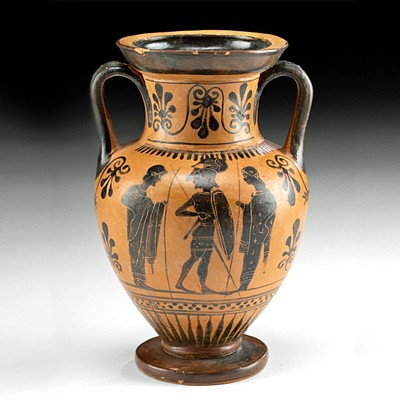Roman Marble Stele, Mother & Child, Greek Text
Lot 72
About Seller
Artemis Fine Arts
686 S Taylor Ave, Ste 106
Louisville, CO 80027
United States
Selling antiquities, ancient and ethnographic art online since 1993, Artemis Gallery specializes in Classical Antiquities (Egyptian, Greek, Roman, Near Eastern), Asian, Pre-Columbian, African / Tribal / Oceanographic art. Our extensive inventory includes pottery, stone, metal, wood, glass and textil...Read more
Estimate:
$12,000 - $18,000
Absentee vs Live bid
Two ways to bid:
- Leave a max absentee bid and the platform will bid on your behalf up to your maximum bid during the live auction.
- Bid live during the auction and your bids will be submitted real-time to the auctioneer.
Bid Increments
| Price | Bid Increment |
|---|---|
| $0 | $25 |
| $300 | $50 |
| $1,000 | $100 |
| $2,000 | $250 |
| $5,000 | $500 |
| $10,000 | $1,000 |
| $20,000 | $2,500 |
| $50,000 | $5,000 |
| $100,000 | $10,000 |
| $200,000 | $20,000 |
About Auction
By Artemis Fine Arts
Mar 9, 2023
Set Reminder
2023-03-09 10:00:00
2023-03-09 10:00:00
America/New_York
Bidsquare
Bidsquare : Exceptional Ancient, Ethnographic, & Fine Art
https://www.bidsquare.com/auctions/artemis-gallery/exceptional-ancient-ethnographic-fine-art-12354
Artemis Fine Arts info@artemisfinearts.com
Artemis Fine Arts info@artemisfinearts.com
- Lot Description
**First Time At Auction**
Roman, Eastern Empire, Imperial Period, ca. 2nd century CE. A magnificent marble funerary stele, hand-carved to display the relief image of a mother and child facing forward and standing in an archway, perhaps representing the threshold between the living and afterlife. Draped in a long veil, the mother stands to the right with arms folded at her waist, holding the fabric of her palla as her stola lies beneath, cascading down her body in billowing folds. The child stands contrapposto to the left, wearing a short tunic, which suggests he is male, and bending his left arm at the elbow, while his right lays to his side holding a small object, perhaps a toy. A pointed hat caps his head. The archway under which they stand is supported by a pair of columns with rectangular capitals that flank the figures and a pair of rosettes on either side of the arch. A beautiful reminder that, like these figures beneath the archway, we are all just passing through! Size: 3.5" L x 10.9" W x 21.6" H (8.9 cm x 27.7 cm x 54.9 cm); 26" H (66 cm) on included custom stand.
The area below the figures bears an inscription in ancient Greek. While the top line likely states the name of the deceased - possibly Zinobia or Zinobius, of who dedicated this stele, or of the deceased's hometown, the bottom line reads "XAIPE," which translates to "farewell."
This piece is rife with symbolism of life's largest and ultimate transition: death. The couple's placement beneath this arch may be read as passing through a gateway, possibly a tomb or Hades, indicating their positioning on the threshold between this world and the next. Additionally, the rosettes are commonly associated with mourning and death. The depiction of these flowers as perpetually ageless serves as an expression of the Roman belief the soul's continued existence. Romans also thought of the bones or ashes of the deceased of generating flowers, as another Roman epitaph reads: "Here lies Optatus, a child ennobled by devotion: I pray that his ashes may be violets and roses, and I ask that the Earth, who is his mother now, be light upon him, for the boy's life was a burden to no one." (J.M.C. Toynbee, Death and Burial in the Roman World [Johns Hopkins University Press, 1971, 1996], pp. 37)
Prior to the 2nd century, Romans cremated their dead; around that time, inspired by the Greek and Etruscan practice of using sarcophagi, they began to place their dead in sarcophagi. This trend spread rapidly throughout the Roman Empire. In the western part of the Empire, sarcophagi were placed inside a mausoleum against a wall or in a niche, so the only decorated panels were on the front and the short sides. This stele probably came from the grave of a high-status Roman citizen.
PLEASE NOTE: Due to recent increases of shipments being seized by Australian & German customs (even for items with pre-UNESCO provenance), we will no longer ship most antiquities and ancient Chinese art to Australia & Germany. For categories of items that are acceptable to ship to Australia or Germany, please contact us directly or work with your local customs brokerage firm.
Provenance: private Vero Beach, Florida, USA collection, acquired before 2003; ex-old English collection, acquired in London in the 1980s
All items legal to buy/sell under U.S. Statute covering cultural patrimony Code 2600, CHAPTER 14, and are guaranteed to be as described or your money back.
A Certificate of Authenticity will accompany all winning bids.
We ship worldwide and handle all shipping in-house for your convenience.
#177245Chipping with loss to lower left corner. Abrasions and weathering commensurate with age. The back has been sliced off making it much easier to display, lighter and more attractive. Great preservation of detail throughout.Condition
- Shipping Info
-
All shipping is handled in-house for your convenience. Your invoice from Artemis Gallery will include shipping calculation instructions. If in doubt, please inquire BEFORE bidding for estimated shipping costs for individual items.
-
- Buyer's Premium



 EUR
EUR CAD
CAD AUD
AUD GBP
GBP MXN
MXN HKD
HKD CNY
CNY MYR
MYR SEK
SEK SGD
SGD CHF
CHF THB
THB














